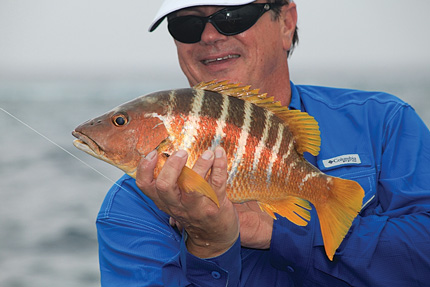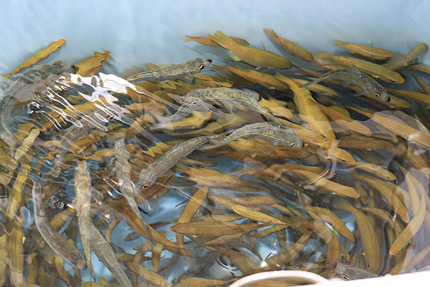.jpg)
A Bahamas offshore adventure to the Abacos pays off big. By George Poveromo
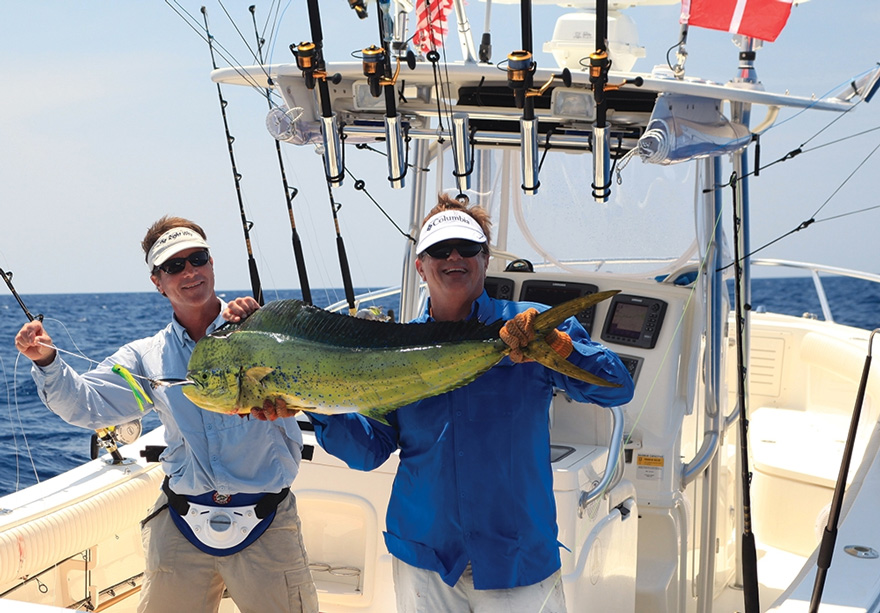
[The Abaco island chain lies at the northern end of the Bahamas island nation, and offers a wealth of both inshore and offshore opportunities. Green Turtle Cay sits among the eastern barrier islands about two-thirds of the way up the chain, in proximity to many differing saltwater habitats.]
The sudden hole in the sea, where the center ’rigger bait had been, got our attention. Before I could shout “Big fish!” 50-pound monofilament melted off the reel. Within seconds, a lit-up blue marlin tail-walked across the ocean. Carl Grassi grabbed the rod and I slowed the MARC VI, retrieved the other lines and teasers, and kept Grassi taut to his fish. As we closed to within 50 feet, the fish hunkered down at the surface. I grabbed the leader to make the catch, then throttled forward with the autopilot, and Grassi fought the fish alongside for the release. It was 2:30 p.m. on our first day of fishing, and our trip had already been made.
We were 34 miles offshore of Green Turtle, over the Great Abaco Canyon, and in addition to the blue marlin, we scored dolphin and an 11-pound tripletail that day.
Shallow History
The day prior, we had run 180 miles from Palm Beach Inlet to the Green Turtle Club Resort and Marina. I’ve visited Green Turtle several times for some of the largest bonefish in the Bahamas. From the white-sand flats off New Plymouth to a couple of rocky, ocean-side cays, there’s usually a sheltered place to find them here. Legendary Abaco bonefish guide Ronnie Sawyer has put me onto numerous big fish in the area, and even a 15-pound mutton snapper on the flats, but I’d promised myself to someday return to Green Turtle and fish the lightly pressured offshore waters.
Offshore Delights
Offshore fishing from Green Turtle can be rewarding when the major pelagics are migrating over the high-profile bottom structure along temperature breaks. The migratory dolphin, tuna, and white and blue marlin sweep past the Abacos chain, as is evident by the catches chalked up out of Boat Harbour, Treasure Cay, Green Turtle Cay and Walkers Cay, when it was operational. Granted, the more-popular bottom structures might be farther east, like the Mushroom, Jurassic Park and the Bridge, but Green Turtle has the Great Abaco Canyon, a nearly vertical formation of rocky cliffs and sediment-covered slopes. Depths range from roughly 5,000 to 11,000 feet. Forage species abound along these slopes and steep walls, attracting dolphin, tuna, and marlin.
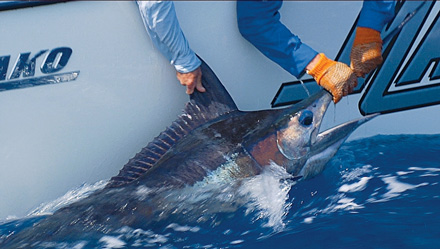
We trolled along a series of 1- to 2-degree surface-temperature breaks, from the canyon’s “shallow” 5,500-foot slope out over the primary drop to 10,000-plus feet.
Our seven-bait spread consisted of large ballyhoo rigged on 300-pound-test fluoro leaders, capped with a small chugger or straight-cut head. We pulled these on outfits spooled with 50- and 80-pound monofilament, and pulled Williamson mullet daisy-chain teasers up close off both sides of the boat. While working a broad, shallow-to-deep trolling pattern, we scanned the surface for debris and monitored the radar for birds. A floating board we discovered gave up two dolphin and an 11-pound tripletail.
Green Turtle offers closer-to-shore trolling, too. Again, seek out surface-temperature breaks, and weed lines rich with bait, rips and, of course, working birds. As for the prime trolling seasons, the last week of April through the second week in May is the most consistent for dolphin. White marlin are more prominent from the end of April into May. And while blue marlin are possible at any time between April and July, June offers the most consistent action. Winter through early spring here means wahoo, sometimes pushing 100 pounds. Though not as consistent as other Bahamas hot spots such as Matanilla, Freeport and San Salvador, yellowfin tuna show up here from mid-June through early July. Blackfin tuna are reliable along the edge in front of Whale Cay between April and July.
Mind the Reefs
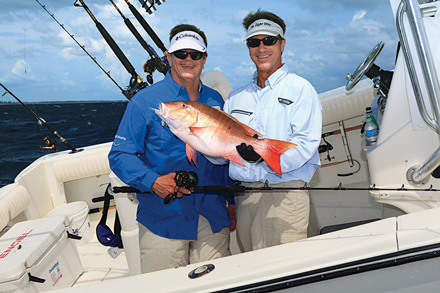
The reef fishing here can be as varied as you like: anchoring and chumming for yellowtail, drifting and jigging, live-baiting, pitching tube lures over coral heads for barracuda, trolling ballyhoo or swimming plugs and small spoons for muttons, cero, king mackerel, and horse-eye jacks.
We began bottom fishing by drifting between 90 and 180 feet of water with ballyhoo-tipped jigs: a simple, yet deadly tactic yielding grouper as heavy as 68 pounds.
Armed with Penn Spinfisher V 5500 reels and Penn Torque 30 reels spooled with 20- and 30-pound braid paired with Penn Bluewater Carnage Jigging Rods, we impaled ballyhoo on 3- and 4-ounce jigs to keep the bait within inches of the reef. To improve action and disperse scent, we limbered up the ballyhoo by crushing the spine along its length and expelling waste through its vent.
I had the hot rod initially. In 170 feet, I felt a hard thump, followed by a pronounced bend in the rod. I reared back on the fish, and it began running off line. I applied as much pressure as I could without parting the braid — a must to keep big fish from holing up or breaking off on the reefs. After a spirited fight on the 20-pound gear, I eased the pressure when I had the fish halfway up in the water column to keep from pulling or straightening the hook. I soon saw pink in the blue depths, and moments later, Grassi slipped the net under a husky mutton snapper.
We also found action on groupers, and hooked a couple we couldn’t slow down. On one drift, Grassi leaned back on a heavy fish. Judging by the arch in his rod and line leaving the reel, I thought we were about to lose another good fish to the reefs. But somehow, he turned the fish and deftly fought it to the surface. His prize: a big red grouper! And this is the way it went — fast action with strawberry, red and Nassau groupers, and even mutton snapper. And best of all, there was no anchor to retrieve when we were done.
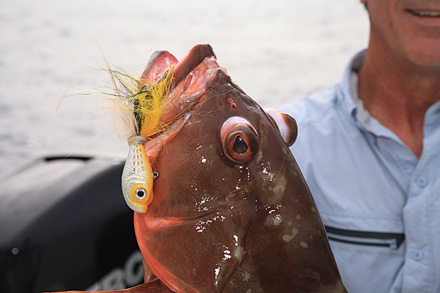
Life on the Hook
We wouldn’t have come this far without going on the hook at least once, so we headed for an offshore wreck where we’d had success on our previous year’s trip to Boat Harbour. With a livewell full of pilchards and wrasses, we anchored ahead of the wreck and chummed as we free-lined baits, and dropped some to the bottom on knocker rigs on 20- and 30-pound fluoro leaders, 4/0 in-line circle hooks, and half-ounce egg sinkers. We used 4500- and 5500-class reels with the live baits, and heavier conventional tackle with 100-pound braid to drop live yellowtail for a big grouper. The live-bait/knocker rigs proved golden, as they got slammed on nearly every drop. We scrapped with yellowtail and big schoolmaster snappers, grouper, horse-eye jacks, cero mackerel and, ultimately, big sharks. Prior to leaving this spot, I pitched a Williamson Jet Popper on a 20-pound-test spinning outfit and enjoyed explosive topwater action with a variety of big jacks.
There’s no denying that Green Turtle is a bonefishing paradise. However, in my opinion, it’s just as good a destination for offshore species, especially blue marlin and a variety of reef fish. In addition to the great offshore fishing, you have the ocean all to yourself most of the time. And who would argue with that?
